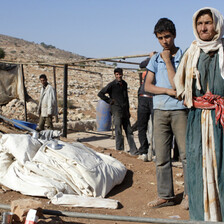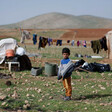The Electronic Intifada 2 January 2013

Palestinians evacuate the northern Jordan Valley prior to Israeli military “live fire” exercises, 8 November 2012.
Xinhua/ZumapressJIFTLIK (IRIN) - For those who recently watched images of the Israeli bombardment in Gaza, the wide open hills of the Jordan Valley in the occupied West Bank appear as a stark contrast.
Flocks of sheep accompanied by their herders cross the hillsides, home to some of the most fertile land in all of historic Palestine.
And yet despite the abundant land and resources, Palestinians living in the valley are some of the poorest in the West Bank, lacking even the most basic infrastructure.
The Jordan Valley is marked by a patchwork of zones in which Palestinians are allowed to live, which leave little room for maneuver.
“These restrictions have removed their ability to be self-sustaining. They are in an artificial humanitarian crisis; they have the capacity, the training, the education, but because of man-made restrictions, they are made vulnerable,” Ramesh Rajasingham from the UN Office for the Coordination of Humanitarian Affairs (OCHA), said.
Out of bounds
For a start, much of the valley is officially out of bounds to Palestinians — 44 percent is marked as closed Israeli military zones (including so-called firing zones) and nature reserves. An additional 50 percent is controlled by Israeli settlements, which are illegal under international law. That leaves only 6 percent for Palestinians, according to figures from Save the Children (“Fact sheet: Jordan Valley,” October 2009 [PDF]).
A second layer of restrictions reinforces this exclusion: Under the Oslo accords, 90 percent of the valley was labeled Area C. In this area of the West Bank, Israel retains full civil and military control, enabling it to restrict Palestinian movement, construction and development projects.
“A few years ago, communities in Area C were self-sustaining; they could trade, sell produce, graze their animals, and move around freely,” said Rajasingham.
Many of the Palestinian Bedouin farming communities in these zones predate the Oslo accords and the firing zones (set up in the 1960s), but they now find themselves increasingly excluded or living a precarious existence.
Most Palestinians there live without sufficient access to clean water, while Israeli settlements nearby have plentiful water supplies subsidized by the Israeli government.
Within the firing zones, more than 90 percent of the Palestinian communities are water scarce with access to less than 60 liters per person per day.
The rate of food security — ready access to enough safe and nutritious food to live healthily — in Area C is 24-34 percent for the shepherds, many of whom live in the firing zones (“The humanitarian impact of Israeli-declared ‘firing zones’ in the West Bank,” OCHA, August 2012 [PDF]).
Threats
Overlooking the valley are multiple Israeli military bases.
Army vehicles speed down the roads during the day, artillery fire echoes from nearby, while at night military helicopters circle overhead.
Seven weeks ago — during the eight-day bombardment in Gaza — tanks, army jeeps and military camps were active in the valley as part of a training exercise carried out by the Israeli military. According to a military spokesperson, the exercise was held to “prepare for various security scenarios.”
The spokesperson added that it was important for “intruders” to “be kept clear from the military areas … for the security of both soldiers and Palestinian civilians.”
“The army came and said ‘if you don’t leave this area for the training exercise, we will demolish your houses. You must go to Tayasir, which is far away from here,” Eid Ahmad Musa al-Fakir, a 68-year-old herder from the village of Hamamat al-Maleh, said.
“It was hard for us to go there with our sheep and our belongings and it’s now winter, we don’t have so much money and the animals are breeding. So we moved just a short distance away to the roadside.”
In preparation for the military exercise, the Israeli army issued more than 40 eviction orders to Palestinian families in the northern Jordan Valley living in or near the firing zones (“Israel to evict up to 250 families in Jordan Valley,” Alternative Information Center, 11 November).
“Afraid to return”
A number of Palestinians returned to their homes, but al-Fakir and his family are unsure of when they will go back.
“The army told us that even if the training exercise is over, we should not come back. Here by the roadside it’s hard for our animals to graze, but we are afraid to return and find that we have to move again,” he said.
Israel’s Coordination of Government Activities in the Territories did not respond to interview requests for specifics about the recent military exercise.
Some 5,000 Palestinians, mostly Bedouin and herding communities, live in designated firing zones across the West Bank, according to the UN’s OCHA.
Palestinians living in firing zones are among the most vulnerable populations in the West Bank with little access to services such as health care and education, and no basic utilities like electricity and sanitation.
Access to firing zones is prohibited to Palestinians without permission from the Israeli authorities and cover about 18 percent of the land in the West Bank.
Residents in these areas are frequently issued with eviction and demolition orders even though “many residents report that there is little or no military training in areas where they reside,” OCHA has noted (“Khirbet Tana: large-scale demolitions for the third time in just over a year,” February 2011 [PDF]).
Where Palestinians have tried to construct, they face opposition from the Israeli government.
Layers of regulation
The Israeli permit regime, which contravenes international law, makes daily living in Area C even more difficult for Palestinians as they are required to apply for permits to construct structures like water cisterns, latrines and houses.
Permits are rarely granted, forcing Palestinians to forego them and risk demolition.
All these restrictions and layers of regulation make daily life in the Jordan Valley precarious.
According to the Ma’an Development Center, an independent Palestinian development and training institution, “Israel has carried out more demolitions in the Jordan Valley than anywhere else” (“Demolitions in the Jordan Valley,” 2012 [PDF]).
OCHA’s factsheet on Jordan Valley settlements says that in 2011 alone there were 200 demolitions of Palestinian structures, including homes, resulting in the displacement of 430 persons.
In some instances, a building is demolished by the Israelis, rebuilt by Palestinians and then demolished again.
Israeli settlers on the other hand are given financial assistance by the Israeli government to encourage settlement expansion.
The settlement of Tomer, south of the Palestinian village of Fasayil, specializes in the production of dates.
According to the Ma’an Development Center, the settlement has become “a flourishing community with a modern infrastructure, prosperous industries and reliable social services” as a result of “tax breaks, grants and other benefits.”
By contrast, “[Palestinian ] homes in Fasayil are made of tin, plastic and mud” and the community has faced four waves of demolitions since January 2011.
There are ten Israeli settler communities partially or completely in the firing zones of the West Bank, though they almost never face threats of demolition.
“They don’t want us here”
Many in the Jordan Valley see military exercises in firing zones as well as repeated house demolitions as an Israeli strategy to empty the land of Palestinians and confiscate it for further settlement expansion and agricultural production.
“This is a mountainous area, with [Israeli] people scattered across the place. Their purpose is to make us all leave so that they can take it for themselves,” Fatima Abid Aouda Soraiya Fakir, one of the women displaced from the village of al-Maitah, said. “They are afraid that we will become established here if we stay, like the village of al-Aqaba which now has schools and clinics.”
Eid al-Fakir, the Palestinian from Hamamat al-Maleh village, agreed. “The army wants everyone in this area to move,” he said. “It’s happening slowly and over time, but they definitely do not want us here.”
Chris Whitman from the Ma’an Development Center said that the recent exercise is a method for Israel to consolidate its power in the valley.
“To have people who are outside the system, herding and moving around is [taken as] a form of defiance,” he said.
“So Israel makes sure these people know the boundaries; makes sure they are not connected to water or electricity; ruins the area with artillery so that the animals cannot graze; and gives them the idea that their existence is temporary.”
The Israeli military declined to respond to these allegations.
Whitman added that Palestinians in the Jordan Valley have become increasingly impoverished over the past twenty years.
Those that have family elsewhere, or can afford to, may eventually choose to leave for larger towns or cities. But many rely on their animals for survival and cannot move elsewhere.
The Palestinians in al-Maitah say that despite their recent experience, they are staying put.
“We are here now and we just want the Israelis to leave us alone,” Ahmad Eid Soraiya Fakir from al-Maitah said. “We are willing to live in any condition if we have to, but we will not leave.”
This item comes to you via IRIN, a UN humanitarian news and information service, but may not necessarily reflect the views of the United Nations or its agencies. All IRIN material may be reposted or reprinted free-of-charge; refer to the copyright page for conditions of use. IRIN is a project of the UN Office for the Coordination of Humanitarian Affairs.

